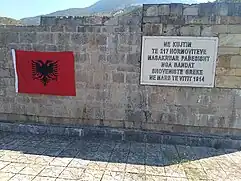Hormovë
Hormovë (definite form: Hormova) is a community in the Gjirokastër County, southern Albania.[1] At the 2015 local government reform it became part of the municipality Tepelenë.[2]
Hormovë | |
|---|---|
.svg.png.webp) Hormovë | |
| Coordinates: 40°14′20″N 20°6′4″E | |
| Country | |
| County | Gjirokastër |
| Municipality | Tepelenë |
| Municipal unit | Qendër Tepelenë |
| Time zone | UTC+1 (CET) |
| • Summer (DST) | UTC+2 (CEST) |
History
Hormovë was one of the Albanian Christian villages in the possession of the House of Moutzohoussates (Albanian: Meçohysaj[3]), the ancestral house of Ali Pasha.[4] It was the largest and militarily strongest village of the region of Rrëzë (Riza).[5]
During his stay in Hormovë in 1769, the Serbian monk Dositej Obradović estimated its size at around 700 houses, all built in stone. The group of 20 locals who greeted him on arrival offered to house him at the Saint Nicholas Monastery, which they claimed could house ten monks, but it was empty because they, as Albanians, do not like to be monks.[6]
In 1784, Hormovë was attacked and destroyed by Ali Pasha as their loyalty to him had been uncertain after having abused his mother. Ali also roasted alive the village's leader, Çavuş Prift[7]
In 1798, Sheh Mehmet Cama from Golem built a Halveti tekke in the village.[8]
In 1821, when the Greek War of Independence broke up, a number of locals formed armed groups and supported the Independence struggle in Peloponnese and Central Greece, under leaders such as Diamantes and Kostas Chormovas (later known as Lagoumitzis).[9][10]
In 1914, 217 Albanian men and boys from Hormovë were massacred on order of Athens by Greek rebels, north of the village of Kodër; inside the premises of the monastery of St. Mary.[11] A lapidary in the village commemorates this massacre.[12]

During World War II, the advancing Greek forces managed to enter the village after the Italian retreat, in December 11, 1940.[13]
Notable people
- Konstantinos Lagoumitzis (1781–1827), fighter of the Greek War of Independence.[14]
Footnotes
- "Location of Hormovë". Retrieved 2010-06-03.
- "Law nr. 115/2014" (PDF) (in Albanian). p. 6371. Retrieved 25 February 2022.
- Koçi, Dorian (2018-09-26). "Pse e rrënoi Ali Pashë Tepelena, Hormovën?" (in Albanian). Retrieved 2022-10-05.
- Skiotis 1971, pp. 225–226
- Koçi, Dorian (2018-09-26). "Pse e rrënoi Ali Pashë Tepelena, Hormovën?" (in Albanian). Retrieved 2022-10-05.
- Koçi, Dorian (2018-09-26). "Pse e rrënoi Ali Pashë Tepelena, Hormovën?" (in Albanian). Retrieved 2022-10-05.
- Skiotis 1971, p. 243
- Hysi, Shyqyri. "Teqeja e Hormovës, dëshmi bashkjetese fetare". Gazeta Tema (in Albanian).
- Pappas 1991, p. 294: "The Souliote units, together with formations of other Epirotes (Cheimarriotes, Chormovites [people from Hormovë], etc.), Macedonians, Cretans, Thessalians, Ionians and other Greeks from outside the liberated areas, became the "shock brigades" of the Greek Revolution."
- Pappas 1991, pp. 317–318: "Among the heterochtons that formed their own units were the Cheimarriotes and Chormovites, from areas of present-day Albania. Included in these units were Cheimarriotes and Chormovites who had served on the Ionian Islands. Unofficial Cheimarriote and Chormovite units took to the field from the beginning of the revolution in 1821. [...] A similar unit, composed of Chormovites and Riziotes, was organized by Diamantēs and Kōstas Chormovas, both of whom had served on the Ionian Islands in Russian and French forces. This unit besieged Nafpaktos in 1821 and later campaigned in Missolongi, Athens and other parts of Greece."
- Pëllumb Xhufi. "Te kisha në Kodër, ku u masakruan 220 burra e djem hormovitë" (in Albanian).
Të dielën, në 27 prill, në fshatin Homovë u përkujtua 100-vjetori i masakrës së burrave të atij fshati këtu e një shekull më parë. Pikërisht, në 29 prill 1914, bandat e ushtarëve dhe të andartëve grekë masakruan 220 burra e djem hormovitë brenda ambienteve të manastirit të Shën Mërisë, mbi fshatin Kodër.
- Van Gerven Oei, Vincent W.J., ed. (2015). Lapidari I (in Albanian and English). Punctum books. p. 192. doi:10.21983/P3.0094.1.00.
Në këtë vend janë vendosur eshtrat e hormovitëve të masakruar nga shovinistët grekë në vitin 1914.
- Bertke, Donald A.; Smith, Gordon; Kindell, Don (15 May 2012). World War II Sea War, Volume 3: The Royal Navy is Bloodied in the Mediterranean. Lulu.com. p. 127. ISBN 978-1-937470-01-2.
11 December Greek troops advanced to Palermo Harbour, Albania, and from J. Sipern to Hormove, Albania. Elsewhere, the Italian troops managed to hold their defensive line.
- Engonopoulos, Nikos (1962). ΜΠΟΛΙΒΑΡ (in Greek). ΙΚΑΡΟΣ. p. 38. ISBN 9789607233387.
Ο Κώστας Λαγουμτζής ή Λαγουμιτζής Χορμοβίτης, από το Χορμοβο της Ηπείρου...
References
- Pappas, Nicholas Charles (1991). "The Veterans, the Philikē Hetaireia and the Greek Revolution". Greeks in Russian military service in the late eighteenth and early nineteenth centuries. Institute for Balkan Studies. pp. 293–324. OCLC 427986248.
- Skiotis, Dennis N. (1971). "From Bandit to Pasha: First steps in the Rise to Power of Ali of Tepelen, 1750–1784". International Journal of Middle East Studies. 2 (3): 219–244. doi:10.1017/S0020743800001112. ISSN 1471-6380.
